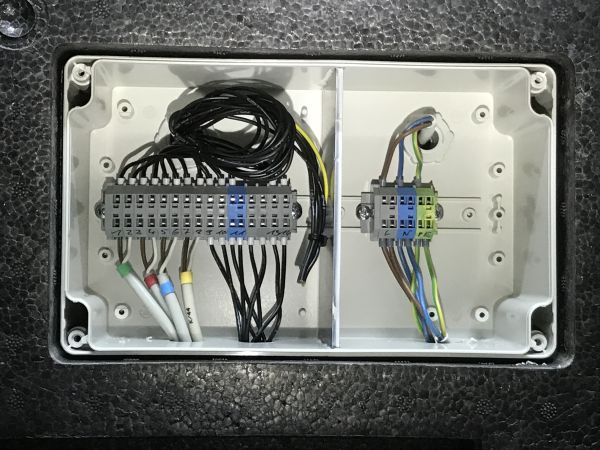PWM Control of Ventilation via I2C bus
The better approach to set the ventilation level continously is to utilize a LED dimmer:
R1 = 100 kOhm, R2 = 10 kOhm
My first approach had been to replace the control panel of the ventilation and to hack the RS232 bus.
Activate the I2C bus
There are many good explanations in the web on how to bring up the I2C bus.
Essentially it takes some steps like:
raspi-config under the "Advanced Options" enable I2C and SPI.
nano /etc/udev/rules.d/51-i2c.rules
KERNEL=="i2c*", GROUP="gpio", MODE="0660"nano /etc/modprobe.d/raspi-blacklist.conf
#blacklist spi-bcm2708 #blacklist i2c-bcm2708nano /etc/modules
snd-bcm2835 i2c-devnano /boot/config.txt
dtparam=spi=on dtparam=i2c1=on dtparam=i2c_arm=on
Install tools for I2C
apt-get updateapt-get install i2c-tools
apt-get install python-smbus
apt-get install libi2c-dev
Initial test of the I2C bus:
i2cdetect -F 1
i2cdetect -y 1
If it should not work, perhaps it takes one more reboot.
On first trial I only got response "UU" at address 0x1b. After some testing I finally found out, that at the RESET pin of the PCA9530, the 3.3 V potential was missing, so my dimming IC was in permanent reset. After some re-soldering, I got
0 1 2 3 4 5 6 7 8 9 a b c d e f 00: -- -- -- -- -- -- -- -- -- -- -- -- -- 10: -- -- -- -- -- -- -- -- -- -- -- UU -- -- -- -- 20: -- -- -- -- -- -- -- -- -- -- -- -- -- -- -- -- 30: -- -- -- -- -- -- -- -- -- -- -- -- -- -- -- -- 40: -- -- -- -- -- -- -- -- -- -- -- -- -- -- -- -- 50: -- -- -- -- -- -- -- -- -- -- -- -- -- -- -- -- 60: 60 -- -- -- -- -- -- -- -- -- -- -- -- -- -- -- 70: -- -- -- -- -- -- -- --
Patch Paul Thermos 200
To control the ventilators via my PCB, I had to patch the connections of my Paul Thermos unit.
Opening the cover with the Paul logo you"ll see:

Of course the transistors are on the PCB, not in the Paul connectors box.
Test the ventilation control
To set the ventilators to 50%, using address 0x60 on bus 1 you may set all registers in one run:
i2cset -y 1 0x60 0x11 0x00 0x80 0x00 0x80 0xe i
where:
0x11 auto increment flag and both output logics with pull up resistors
0x00 frequency of PWM0
0x80 PWM0
0x00 frequency of PWM1
0x80 PWM1
0x0e xxxx1110 set output0 to PWM0 and output1 to PWM1
Or set one PWM by
i2cset -y 1 0x60 0x02 0x80
and read back that register
i2cget -y 1 0x60
Python interface
""" PWM to control Ebmpapst ventilators in Paul Thermos 200 Dr. Arne Jachens 2020-06-20 """ #import smbus from smbus2 import SMBus class HvcSendI2C: def __init__(self): self.bus = SMBus(1) # 0 = /dev/i2c-0 , 1 = /dev/i2c-1 self.ADDRESS = 96 #0x60 # address on bus, check: i2cdetect -y 1 self.REG_MODE = 17 #0x11 # auto increment flag, output logics with pull up resistors def setPWM(self,level): """ Set the ventilation level [0:1], where 1 is maximal, here both ventilation levels are set equal. """ #level percent to integer levelInt = [] for i,lev in enumerate(level): levelInt.append(int( 255*(1.0-lev) )) #compose message bytes values=[] values.append( 00 ) # frequency of PWM0 values.append(levelInt[0]) # PWM0 values.append( 00 ) # frequency of PWM1 values.append(levelInt[1]) # PWM1 values.append( 14 ) # xxxx1110 set output0 to PWM0 and output1 to PWM1 #send message self.bus.write_i2c_block_data(self.ADDRESS, self.REG_MODE, values) """ for testing """ if __name__ == "__main__": I2C = HvcSendI2C() level = [0.5, 0.5] I2C.setPWM(level)